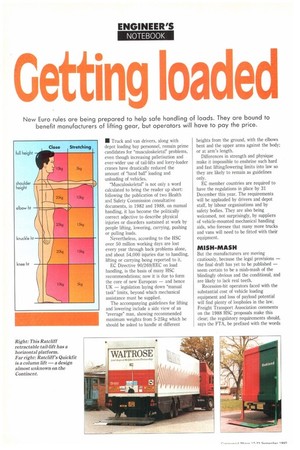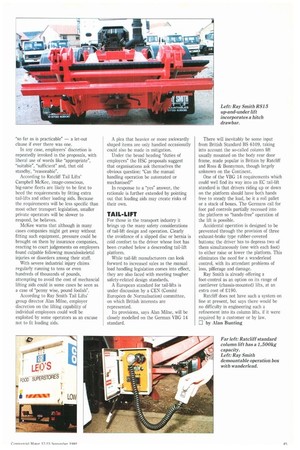Getting loaded
Page 46

Page 47

If you've noticed an error in this article please click here to report it so we can fix it.
New Euro rules are being prepared to help safe handling of loads. They are bound to benefit manufacturers of lifting gear, but operators will have to pay the price.
• Truck and van drivers, along with depot loading bay personnel, remain prime candidates for "musculoskeletal" problems, even though increasing palletisation and ever-wider use of tail-lifts and lorry-loader cranes have drastically reduced the amount of "hand ball" loading and unloading of vehicles.
"Musculoskeletal" is not only a word calculated to bring the reader up short: following the publication of two Health and Safety Commission consultative documents, in 1982 and 1988, on manual handling, it has become the politically correct adjective to describe physical injuries or disorders sustained at work by people lifting, lowering, carrying, pushing or pulling loads.
Nevertheless, according to the HSC over 50 million working days are lost every year through back problems alone, and about 54,000 injuries due to handling, lifting or carrying being reported to it.
EC Directive 90/269/EEC on load handling, is the basis of many HSC recommendations; now it is due to form the core of new European — and hence UK — legislation laying down "manual task" limits, beyond which mechanical assistance must be supplied.
The accompanying guidelines for lifting and lowering include a side view of an "average" man, showing recommended maximum weights from 5-25kg which he should be asked to handle at different heights from the ground, with the elbows bent and the upper arms against the body; or at arm's length.
Differences in strength and physique make it impossible to enshrine such hard and fast lifting/lowering limits into law so they are likely to remain as guidelines only.
EC member countries are required to have the regulations in place by 31 December this year. The requirements will be applauded by drivers and depot staff, by labour organisations and by safety bodies. They are also being welcomed, not surprisingly, by suppliers of vehicle-mounted mechanical handling aids, who foresee that many more trucks and vans will need to be fitted with their equipment.
MISH-MASH
But the manufacturers are moving cautiously, because the legal provisions — the final draft has yet to be published — seem certain to be a mish-mash of the blindingly obvious and the conditional, and are likely to lack real teeth.
Recession-hit operators faced with the substantial cost of vehicle loading equipment and loss of payload potential will find plenty of loopholes in the law. Freight Transport Association comments on the 1988 HSC proposals make this clear; the regulatory requirements should, says the FTA, be prefixed with the words "so far as is practicable" — a let-out clause if ever there was one.
In any case, employers' discretion is repeatedly invoked in the proposals, with liberal use of words like "appropriate", "suitable", "sufficient" and, that old standby, "reasonable".
According to Ratcliff Tail Lifts' Campbell McKee, image-conscious, big-name fleets are likely to be first to heed the requirements by fitting extra tail-lifts and other loading aids. Because the requirements will be less specific than most other transport legislation, smaller private operators will be slower to respond, he believes.
McKee warns that although in many cases companies might get away without fitting such equipment, pressure could be brought on them by insurance companies, reacting to court judgements on employers found culpable following musculoskeletal injuries or disorders among their staff.
With severe industrial injury claims regularly running to tens or even hundreds of thousands of pounds, attempting to avoid the cost of mechancial lifting aids could in some cases be seen as a case of "penny wise, pound foolish".
According to Ray Smith Tail Lifts' group director Alan Milne, employer discretion on the lifting capability of individual employees could well be exploited by some operators as an excuse not to fit loading aids. A plea that heavier or more awkwardly shaped items are only handled occasionally could also be made in mitigation.
Under the broad heading "duties of employers" the HSC proposals suggest that organisations ask themselves the obvious question: "Can the manual handling operation be automated or mechanised?"
In response to a "yes" answer, the rationale is further extended by pointing Out that loading aids may create risks of their own.
TAIL-LIFT
For those in the transport industry it brings up the many safety considerations of tail-lift design and operation. Clearly the avoidance of a slipped disc or hernia is cold comfort to the driver whose foot has been crushed below a descending tail-lift platform, While tail-lift manufacturers can look forward to increased sales as the manual load handling legislation comes into effect, they are also faced with meeting tougher safety-related design standards.
A European standard for tail-lifts is under discussion by a CEN (Comite Europeen de Normalisation) committee, on which British interests are represented.
Its provisions, says Alan Milne, will be closely modelled on the German VBG 14 standard. There will inevitably be some input from British Standard BS 6109, taking into account the so-called column lift usually mounted on the body rear door frame, made popular in Britain by Ratcliff and Ross & Bonnyman, though largely unknown on the Continent.
One of the VBG 14 requirements which could well find its way into an EC tail-lift standard is that drivers riding up or down on the platform should have both hands free to steady the load, be it a roll pallet or a stack of boxes. The Germans call for foot pad controls partially recessed into the platform so "hands-free" operation of the lift is possible.
Accidental operation is designed to be prevented through the provision of three exhaust-brake type rubber-covered buttons; the driver has to depress two of them simultaneously (one with each foot) to either raise or lower the platform. This eliminates the need for a wanderlead control, with its attendant problems of loss, pilferage and damage.
Ray Smith is already offering a foot-control as an option on its range of cantilever (chassis-mounted) lifts, at an extra cost of E190.
Ratcliff does not have such a system on line at present, but says there would be no difficulty in engineering such a refinement into its column lifts, if it were required by a customer or by law.
by Alan Bunting




























































































